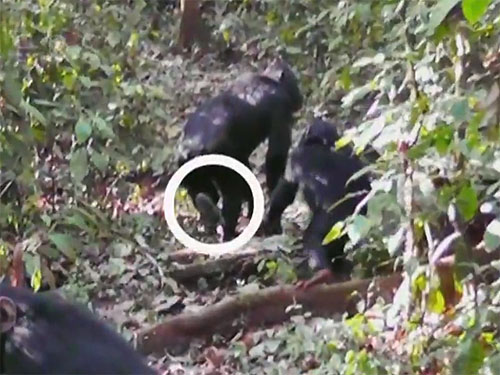I don't think I ever read "Doctor Doolittle" and may have seen the movie, but I'm not sure. But throughout my life I have read enough animal books about the relationship between humans and their animals, relationships that have almost an esp about them, that I always dreamed of having an animal I could communicate with, the way Alec and The Black understood each other, or the way The Master and his collies understood each other.
Polly and I have probably the closest thing to a non-verbal communication. She works harder at it than I do, spending every waking moment studying me trying to figure out if I'm getting ready to go out, going into the kitchen for a snack or for some other reason, whether I'm going to sit in the recliner or Walt's chair. She bases or own actions on which she decides she thinks I'm going to do. If I'm going to the kitchen for a snack, she's right on my heels, but if I'm going to get a glass of water, she doesn't bother to get up. If I stand up, ready to go out, she's dancing around the family room waiting for the snack she knows I will give her, but if I'm just going into my office, she barely lifts her head.
For my part, I have the luxury of studying her body language, trying to decipher what is going on in that little head. Sometimes I get it right, sometimes I don't.
But I watched a Nova special last night (What are Animals Saying?), when I was trying to get back to sleep, and it was so fascinating it kept me awake. It was on how animals communicate, non-verbally, with each other. I have such admiration for people who spend literally decades observing a certain species of animals. One woman, for example, spent so much time over 10+ years living on the outskirts of a tribe of chimpanzees that she almost felt like part of the family. She observed the subtle ways in which they interact with each other.
The scratches of chimps aren't simply random gestures, but part of a secret language. It can be a signal to a child that can either mean "grooming" or "let's travel together." A mother who is walking with her baby and quietly lifts her back foot a bit, is telling the baby to get on her back so she can carry him.

They studied primates who have learned how to communicate with humans and how many words or symbols they learned, but I think they gave short shrift to KoKo, the gorilla who not only has a large vocabulary of American Sign language, but is able to use her vocabulary to express her desires and her feelings and even create her own language, based on compounds of the words she knows.
Whales are vocal learners, as opposed to primates who learn by watching other primates Their songs are some of the most complicated forms of communication. A single song can be anywhere from 5 minutes to half an hour and, like our songs, consist of repeated phrases and themes. There are more than 30 sound types that can be recognized, within the repertoire, which include such things as grunts, shrieks, etc. They record the sounds and chart them and over years are able to make some sense--they think--of them. The important thing is that they recognize the sounds, and communicate that way. (Whoever said that "dumb animals" have no language?)
Only the males do the singing and the scientists decided to try to map them. There are tens of thousands of whales living in separate groups and they were able to arrange the songs into types like the blue song type or the red song type

It ended up being like a game of "telephone" where a song originated in, say, Australia in one year and the next year it had moved on to the next island group, while Australia group was singing a different song. The original song then moves on to the next island group and the second group takes up the new song from Australia until over several years all groups in all locations sing the same songs, just not at the same time.
This kind of stuff is endlessly fascinating to me (and I never even got to bats, spiders, birds, dolphins and mice). Needless to say, it did not put me to sleep. The most amazing thing I learned was Zipf's law, which is so complicated I can't begin to explain it, but if you're interested, check Wikipedia. It's described as an empirical law formulated using mathematical statistics that refers to the fact that many types of data studied in the physical and social sciences can be approximated with a Zipfian distribution, one of a family of related discrete power law probability distributions. Zipf distribution is related to the zeta distribution, but is not identical. Yeah a mouthful, but if you are able to make your way through the math of it all, it's fascinating to learn that our human language has the exact same structure as that of animals.
But for sleep, I had to turn on the news and find out what outrageous things our glorious leader had done or said today. I don't know where that would all be on a map scale of language, but it did finally knock me out.

No comments:
Post a Comment